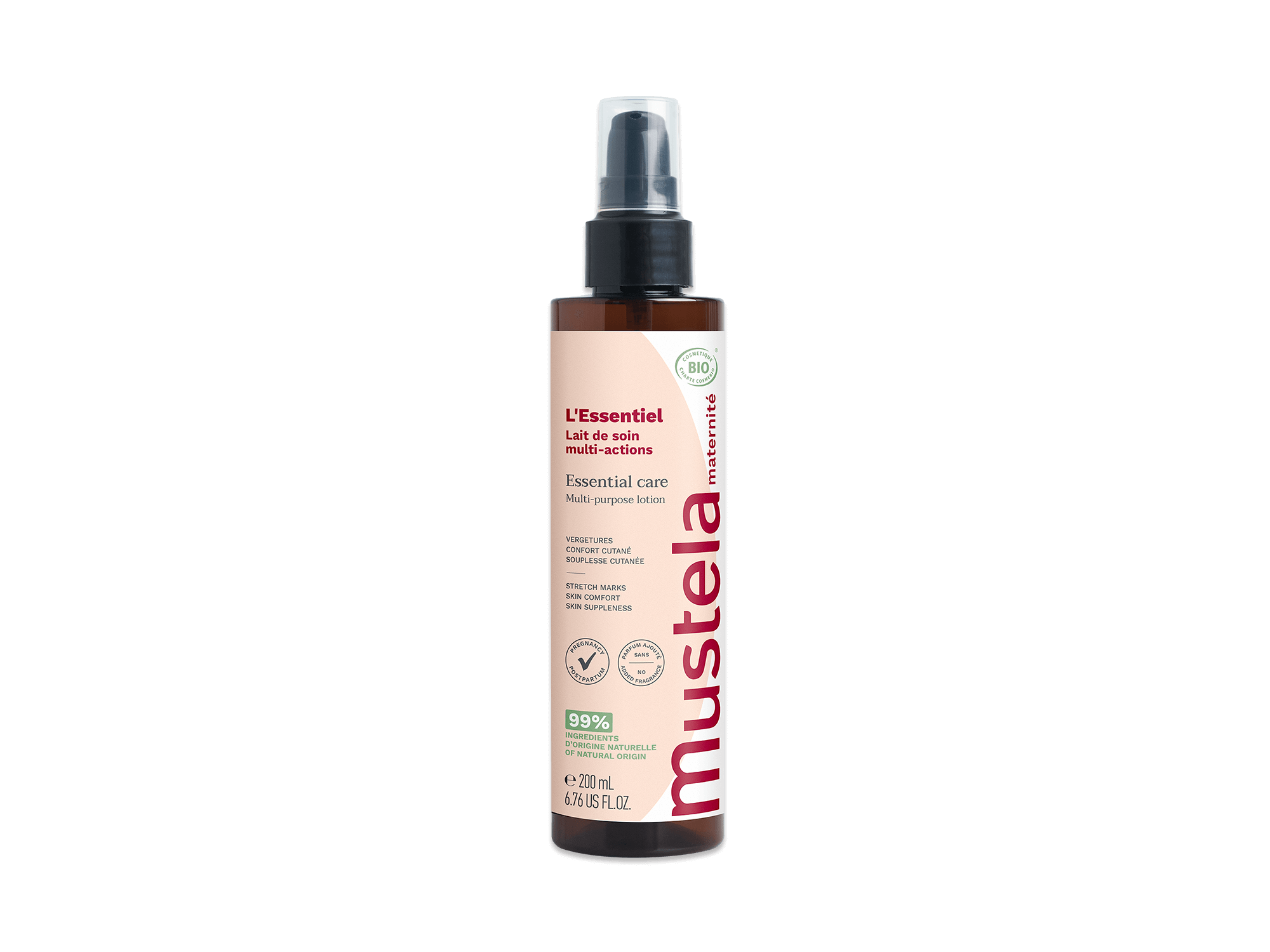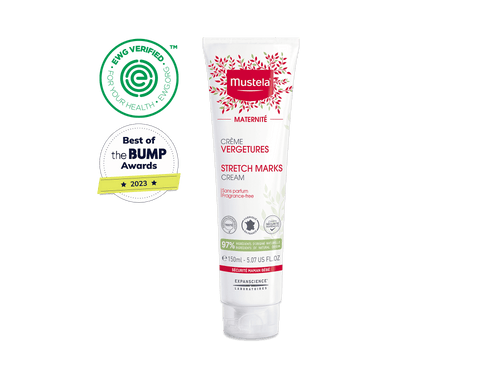With a new baby at home, you’re still getting used to what life looks like with a little one (or another little one!). If you’ve decided to breastfeed, which breastfeeding positions work best for you and your baby is another aspect of motherhood that you’ll need to figure out.
Each mom and baby is different, and there is no one “right” position for breastfeeding. In this article, the baby experts at Mustela offer explanations of common breastfeeding positions, followed by some general tips for breastfeeding.
But before we get to that, we’re going to take a quick look at the benefits of breastfeeding and why your breastfeeding position is so important!
Benefits Of Breastfeeding

If breastfeeding your baby has been more of a challenge than you expected, you may be tempted to just throw in the towel and reach for the nearest bottle.
While there’s nothing wrong with bottle feeding, there are some special benefits from nursing your little one the old-fashioned way. Before you give up, we just thought we should remind you of some of them.
Nursing Benefits For Baby
As you probably already know, when babies are born, their immune systems are very fragile and it can be easy for them to get sick by catching a virus or infection.
Breast milk is Mother Nature’s way of helping your little one build the strength they need to fight off these threats to their health. That’s because it’s packed with loads of antibodies and nutrients, which all help to boost your baby’s immune system.
In addition to providing your baby with the nutrition they need, breastfeeding is also great in helping you and your little one develop a strong bond.
At this stage, your infant is learning a lot from their environment, including your scent, your voice, and your touch.
When they are a couple of days old, it may be hard for them to keep their eyes open for too long. However, as they get older and stronger, you will notice your little one starting to look into your eyes and also study your face.
Nothing in the world can compete with these special moments that breastfeeding offers for both you and your baby.
Nursing Benefits For Mom
In addition to the bond you’re building with your child, breastfeeding plays an essential role when it comes to your health.
Studies have shown that nursing has incredible health benefits for mothers, including lowering your risk of developing ovarian and breast cancer.
Breastfeeding has also been linked with helping trigger your uterus to contract and shrink back to its pre-pregnancy state more quickly. Nursing your little one can also allow you to lose that baby weight and stay healthy.
You’re probably reading this article because you want to start (or continue) breastfeeding in a way that’s comfortable for you and your baby. Before we get into the most common positions, let’s talk about why breastfeeding positions are important in the first place.
Why Breastfeeding Positions Are Important

In addition to simply keeping you comfortable, finding a good breastfeeding position is important for one main reason: it helps your baby to latch on correctly.
When your little one doesn’t latch on correctly to your nipple, they might not feed well or get enough milk. An incorrect latch can also cause some pretty uncomfortable damage to your nipples and put you at risk for soreness or cracking.
For healthy and comfortable breastfeeding, experiment with various breastfeeding positions to find the best one. If you’ve found a couple that work for you, you can even change positions every now and then. This switch-up could help avoid sore nipples.
Expert tip: Whether you already have sore nipples or just want to show them a little TLC during these breastfeeding days, apply Mustela’s Nursing Comfort Balm!
This soothing nipple cream will ease discomfort and moisturize sensitized nipples. Plus, it’s environmentally friendly, made of 100% ingredients of natural origin per ISO 16128 standard, and safe for both you and your baby during prenatal and postpartum pregnancy.
Common Breastfeeding Positions
No matter which breastfeeding position you use, lend a hand to help your baby latch on correctly. Touch their upper lip with your nipple so they open their mouth big and wide.
Then, bring their head to your breast (not your breast to their head) and put their chin to your breast first, followed by their mouth.
If you have to take baby off for any reason, break the suction by gently pushing down on your skin near their mouth or inserting your finger into the corner of their mouth. Don’t cause yourself unnecessary pain by unlatching suddenly!
Without further ado, we’ll explain a few of the common breastfeeding positions so you can give them a try for yourself.
Cradle Hold

The cradle hold is one of the most common breastfeeding positions and probably what you imagine when you think of breastfeeding.
Sit up and hold your little one in your arm on the same side as the breast you’ll use. Their head will be in the bend of your elbow, facing your breast, with that forearm and hand holding the rest of their body.
You and your little one should be facing each other. Your other hand will be free to cup your breast if needed.
Crossover Hold
With the cradle hold, your baby is held with the same arm as the breast you’re nursing from. But with this breastfeeding position, the crossover hold, you hold your baby with the opposite arm.
If you’re nursing from your left breast, hold your baby’s head in your right hand and let their body rest on your right forearm. Your wrist will be on their upper back and you can use your fingers to support their head behind their ears.
You’ll have your other hand free to support your breast or, if all is going well, relax and take a sip of tea!
Laid-Back Position
Just based on its name, you can probably guess how this breastfeeding position works. Lean back or recline (you don’t have to lie completely flat), and then put your baby face down on your stomach with their head at your breast.
The positioning of their body doesn’t have to be exact as long as you’re front-to-front with them and they can reach your nipple to latch on. (This position is great for skin-to-skin contact!)
You may end up directing your nipple toward their mouth, but many babies automatically latch on in this position.
If you’ve had a C-section and need to protect your stomach (or just want to switch things up!), try the laid-back position with your baby’s body across your shoulder.
Side-Lying Position

This position also involves you and baby lying down facing each other, except on your side.
Lie down on the side of the breast you’re going to give first and place your baby on their side facing you. Their mouth should be at the level of your nipple. You’ll have your top arm and hand free to cup your breast.
Dangle Feeding
Make gravity work to your advantage with this breastfeeding position. Dangle feeding is exactly what it sounds like — you let your breasts dangle so your baby can nurse.
For this position, your baby will always be flat on their back but your position can vary somewhat. One option is to put your baby on the floor and get on all fours.
You can also experiment with leaning over your little one while they are lying flat on the couch or bed. Another easy way to do this is to sit on the couch and lean over your baby lying in your lap.
While it’s not the most comfortable position, dangle feeding might be useful for you if you have mastitis or a blocked duct. Gravity will do its best to pull the milk down and clear a blocked duct.
Football Hold
In this position, hold your baby’s head with your hand on the same side as the breast you’re giving. Then tuck your baby’s body between your arm and your side.
The football hold works especially well for twins or for mommies who have a tender tummy from a C-section.
Koala Hold

The koala hold is an upright breastfeeding position, which means you and your little one are both upright, usually sitting.
This position is perfect for older ones who can hold themselves up without any help, but you can also do the koala hold with new babies if you give them plenty of support.
Sit with your baby also in a sitting position on one or both of your legs, their head at your breast. If your little one is big enough, their legs should straddle your thigh so they’re completely facing you, not twisted.
Tips For Breastfeeding Success
To help breastfeeding go as smoothly as possible no matter which position you choose, here are a few simple things you can do for yourself and your little bundle of joy.
1) Watch For Your Baby’s Hunger Cues

If your baby is crying, they might be ready for some milk! But crying is a late hunger cue and means that your baby is really hungry. If that’s the case, you might have a harder time getting them to latch on correctly.
Instead of waiting for your little one to cry, look for earlier hunger cues that tell you they’re ready to nurse. You may notice them sucking on their fingers or opening their mouth and moving their head side-to-side, which is called rooting.
2) Learn To Tell When They’re Satisfied
Since your baby can’t yet talk, it can be tricky to tell when they are full. Not overfeeding your little one is just as important as not underfeeding them. How do you know when they have had enough?
When they are full, babies will usually stop suckling and turn their faces away. This is a common sign that they have had enough (for now).
Besides your baby’s non-verbal communication, your body may also be able to tell you if your little one has had a good meal.
Look at your breasts before nursing and then after nursing. You may notice that before, they were fuller and more firm, and after, they may become softer.
In addition, one of the best ways to know that your baby’s eating well is their growth chart. Your healthcare provider will measure your little one’s weight, height, and head circumference at every check-up. They will then plot all this information on their growth chart.
As long as your baby’s chart moves in a healthy upward trend, you can be assured that your little one is eating enough.
3) Be Prepared
Before you sit down to nurse, collect everything you might need. Remember you could be sitting there for a while!
To make yourself comfortable, you may want a couple of pillows or a breastfeeding pillow. Then grab a book, your phone, the tv remote, or whatever else might help you relax and enjoy this time.
Don’t forget to pour something to sip on while you nurse. Also, make a potty stop beforehand so you won’t be squirming halfway through nursing!
4) Think About Your Bra

When it comes to nursing, you’ll want to be as comfortable as possible at all times. And a well-fitting nursing bra can offer you the comfort you need!
Nursing bras are great because they are very comfortable and make it easier to unclip and nurse your little one at any moment, without much struggle.
Most moms will purchase nursing bras before giving birth so they don’t have to worry about running to the store when they’re in the postpartum phase. If you do this, be sure to get a size bigger than usual to accommodate your milk-filled breasts.
Breast pads are also great to have handy, especially because milk might leak from your breasts at times. There are many different types and some may irritate your skin, so opt for pads made from organic products, as these tend to be more gentle on skin.
If you can’t get breast pads right away, that’s OK. In the meantime, you can fold up a soft cloth (like a handkerchief) and place it in your bra.
Whichever option you choose, you definitely want something absorbent so that you don’t mess up your tops.
5) Take Care Of Your Skin
In more than one way, growing your little one and breastfeeding takes quite a toll on a mom’s body! You look after your little one every day — take care of yourself as well by tending to your skin.
Grab Mustela’s Stretch Marks Set to nourish and hydrate your skin during pregnancy and postpartum.
This set comes with two important products: A Stretch Marks Cream, which will give your skin the added moisture it needs and help prevent the appearance of stretch marks during prenatal and postpartum pregnancy, and a Stretch Marks Oil for even deeper hydration.
Both products are made with ingredients of natural origin per ISO 16128 standard and are safe for you and your baby.
6) Attend A Breastfeeding Class If Necessary

When it comes to nursing, most people assume that the process will come naturally. Well, not quite. Sometimes, figuring out where or how to position yourself, your breasts, and your baby can be challenging.
If you’re struggling, consider breastfeeding classes, where you can have hands-on experience from a trained professional who’s helped many other women in your position.
You don’t have to wait until you give birth to attend breastfeeding classes. If you’re still pregnant, that’s OK! Many pregnant women have enjoyed the benefits of understanding the different positions of nursing well before giving birth.
These classes may be available at a local clinic or hospital. Besides a quick Google search, your healthcare provider can help recommend some excellent places.
7) Try To Increase Your Milk Supply
Some women will naturally produce a lot of milk right after giving birth, while others may need a little bit of extra help.
If you have a low milk supply, here are a few simple changes that may help to make a big difference:
- Breastfeed more often
- If you want your child to get used to the bottle so that it’s easier for someone else to feed them, keep pumping your breasts to continue stimulating them to produce more milk
- Drink plenty of water and enjoy a healthy, balanced diet to give you and your baby the nutrition you need
Wondering why you have a low milk supply? Here are a few common reasons some women produce less milk.
Not Breastfeeding Enough
The more your little one nurses the more breastmilk your body will produce. If you’re hoping to breastfeed for a while, try to give your baby more nursing time.
Long Breaks At Night
Many mothers who schedule their feedings try to stretch out the nighttime feeding sessions. Unfortunately, this affects the demand-and-supply nature of your milk supply. Remember: The less your baby nurses, the less milk your body will produce.
Large Quantities Of Certain Herbs
Most people opt for natural herbs under the assumption that they can do us no harm. Unfortunately, not all herbs were created equal.
Herbs and spices like peppermint, parsley, lemon balm, and thyme can affect your milk supply when consumed in large quantities. You don’t have to completely rid these from your diet, but it’s important to have them in moderation.
In addition to these common reasons, there may be underlying health conditions. If you suspect that your low milk supply is health-related, speak to your healthcare provider, as they will be able to recommend the best products for your unique situation.
Now that you have a few tips to help you get started with breastfeeding your little one, here is what you’ve been waiting for. The top breastfeeding positions you can try out today!
Make Breastfeeding Work For You And Your Baby

Try the positions mentioned in this article to find what works best for both you and your baby. And don’t forget to take care of yourself in the process! Use Mustela’s Stretch Marks Cream and our Stretch Marks Oil to care for your hardworking breasts.
Breastfeeding can be frustrating and challenging at times, but once you find the right breastfeeding position, you’ll savor the moments you get to spend snuggling and nursing your little one!

















